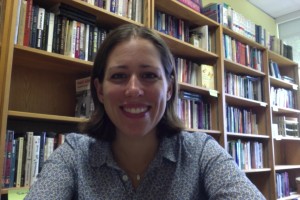 Professor Emily Sigalow, a Postdoctoral Fellow in the Department of Sociology at Brandeis University, presented “Making Meditation Jewish: The Construction of a New Contemplative Jewish Practice” at our recent, November 12, faculty colloquium.
Professor Emily Sigalow, a Postdoctoral Fellow in the Department of Sociology at Brandeis University, presented “Making Meditation Jewish: The Construction of a New Contemplative Jewish Practice” at our recent, November 12, faculty colloquium.
Dr. Sigalow holds a PhD in Near Eastern and Judaic Studies and Sociology from Brandeis University, and her research interests focus on the sociological study of contemporary Jewish life. Prior to studying at Brandeis, Dr. Sigalow spent five years working and studying in Israel and obtained her M.A. from Ben-Gurion University. In her work, Dr. Sigalow examines the interplay between Judaism and Buddhism in America; and her current manuscript, The JUBUs: The Encounter between Judaism and Buddhism in America, traces the way in which practices in Judaism and Buddhism evolved in relation to each other in America since 1893.
In her presentation, Dr. Sigalow outlined the history of the meditative movement in American Judaism and the ways in which it was adapted from Buddhist practices. Dr. Sigalow attributes the wide dissemination of Buddhist meditative practices in liberal Jewish cultural life to several factors, key among them the repackaging of Buddhist practices into a Jewish “cultural container.” So effective was this rebranding, over the last few decades by teachers and sponsors of the Jewish Meditative Movement, that modern practitioners are often unaware of the movement’s Buddhist roots, viewing the movement instead as a revival of ancient Jewish meditative practices. In actuality, as Dr. Sigalow demonstrates, the ancient Jewish mystical traditions have now taken on a decidedly Buddhist approach.
The instructors at Jewish Meditation Centers (JMC) originally learned meditative practices from Buddhist teachers, but by tailoring Buddhist meditation to a Jewish audience and deemphasizing the Buddhist roots of such practices, teachers were able to appeal to a wide segment of Jews so that today, Jewish Meditation Centers can be found throughout the country in synagogues, day schools, and JCCs. Meditative Centers are styled on Buddhist centers, incorporating a simple and uncluttered atmosphere and utilizing the Indian meditation bell, but are made compatible with Jewish tradition by removing statues of Buddha and other iconography. Buddhist symbols are replaced with Jewish ones; for instance, traditional Buddhist prayer cushions may be inscribed with the Star of David and the Tibetan Prayer Flag replaced with a Jewish one. Additionally, Jewish prayers, blessings, and Torah readings have been brought into the meditative sessions.
Incorporating the weekly Torah portion and Jewish prayers serve to connect meditative practices to spiritual ones, appealing to a largely secularized liberal Jewish community. By successfully making these spiritual connections, Jewish Meditation Centers have found a home in Jewish religious spaces in a way that other similar practices, such as yoga, have not.
Dr. Sigalow conducted a fascinating presentation on Jewish meditative practices and we very much look forward to learning more about her work. In addition to examining the interplay between Buddhism and Judaism in America, Dr. Sigalow is currently working on a collaborative research project examining Ashkenazi Jewish women in the United States who carry a BRCA gene mutation and understanding the ways in which they manage their risk compared to their counterparts in Israel.